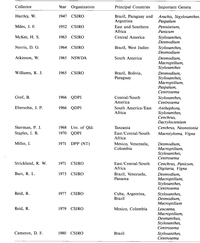


Chapter 1
I Groping In A Strange Environment: 1788-1851
II Farmers Take The Initiative: 1851-1888
III Enter Education And Science: 1888-1927
IV Agricultural Science Pays Dividends: 1927-1987
V Examples Of Research And Development 1928-1988
i Land assessment
ii Improving the environment
iii Adapting to the environment
iv Improving farm management
VI International Aspects Of Agricultural Research
VII Future Prospects
VIII Acknowledgements
References
Index
Search
Help
Contact us

Adapting to the environment
All the domesticated plants and animals which are of economic importance in Australian agriculture have either been introduced from overseas or bred in Australia from imported germplasm. Although many of the species used in the major farming in dustries, such as wheat, sheep, dairy and beef cattle, poultry and pigs came from the United Kingdom or from other countries in western Europe, the search for crops, forage plants and livestock suited to sub-tropical and tropical regions in Australia's north has extended throughout many parts of the world, including Africa, the Middle East, the Indian sub-continent, Central and South America, and Asia. In many cases the original cultivars or breeds that were imported have been so improved by plant and animal breeders in Australia, (both farmers and scientists), that they are now being successfully exported to the regions from which they originally came.Unfortunately, in addition to importing a wide range of economically beneficial plants and animals, there has also occurred a considerable, and partly accidental, introduction of exotic weeds, diseases, parasites, pests and predators that have cost the Australian farmer dearly. Farming would have been much easier and less costly in many localities if, for example, rabbits, sparrows, foxes, blackberries, Paterson's curse, and ragwort had not been brought into the country.
Serious though the effects of these introduced weeds, pests, diseases and predators have been, Australian farmers should be grateful for the efficiency of the Commonwealth and State quarantine services which, with notable success, have so far prevented the entry of a vast array of plant and animal diseases. For example, since the Federal Quarantine Act of 1908, which replaced earlier State Acts dating from 1871, 'only two diseases affecting grazing animals, rinderpest and scrapie, have penetrated the quarantine barrier and both were quickly eradicated'.[74]
Australia is said to have the strictest quarantine code in the world and the seriousness of the potential risks from the introduction of exotic diseases can scarcely be exaggerated. Quarantine services have served Australia's agricultural industries exceptionally well and in recent years the animal services have been greatly strengthened by the development of a high security animal quarantine station on the Cocos Islands and a maximum security Australian Animal Health Laboratory in Victoria. Nevertheless constant vigilance will be needed indefinitely if Australia is to continue to avoid the catastrophic consequences for our crop and livestock industries of disease introductions from Asia, Africa and South America.
Not all introduced micro-organisms, however, are pathogenic and undesirable. For example, a recent and unusual introduction to benefit grazing animals in northern Australia has been the importation of cultures of rumen bacteria derived from goats in Hawaii. Inoculations with these bacteria enable cattle to graze species of the important leguminous shrub Leucaena without losing weight or showing signs of toxicity.
Countless examples could be quoted of useful imports of biological resources, and of the benefits of breeding new and better adapted plant cultivars and animal breeds in Australia. The following brief references to forage plants and livestock for northern Australia and to rhizobial bacteria reflect the range and importance of this valuable field of technological development.
Forage plants for Northern Australia
Although forage accessions were recorded by the Queensland Department of Primary Industry (QDPI) as early as 1919, and some accidental introductions of Stylosanthes humilis from Brazil were made in the early 1900s, most systematic collections of tropical and sub-tropical forages were made after the Second World War. Table 1 lists the major collections, the name and affiliation of the collector, date of collection, countries visited and principal genera collected. By 1962 some 2000 tropical forage legumes had been introduced by CSIRO although, because of inadequate storage facilities, about half of these were lost through seed deterioration. By 1984 the collection had grown to be the largest in the world, with a total of 16 000 viable accessions comprising 12 000 legumes and 4,000 grasses. Because of the large amount of material on hand, the number of collecting missions declined after 1973 and emphasis was placed on classifying and evaluating the. collections.

Organisations in Australian Science at Work - Australian Animal Health Laboratory, Vic.; Queensland. Department of Primary Industry on forage plants
 |
Australian Academy of Technological Sciences and Engineering |  |
© 1988 Print Edition pages 40 - 41, Online Edition 2000
Published by Australian Science and Technology Heritage Centre, using the Web Academic Resource Publisher
http://www.austehc.unimelb.edu.au/tia/046.html